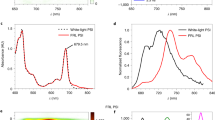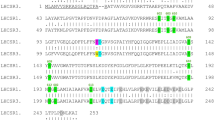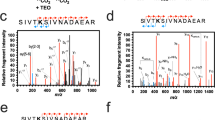Abstract
In photosynthetic organisms, the production of dangerous oxygen species is stimulated under high irradiance. To cope with this stress, these organisms have evolved photoprotective mechanisms. One type of mechanism functions to decrease the energy arriving at the photochemical centres by increasing thermal dissipation at the level of antennae. In cyanobacteria, the trigger for this mechanism is the photoactivation of a soluble carotenoid protein, the orange carotenoid protein (OCP), which is a structurally and functionally modular protein. The inactive orange form (OCPo) is compact and globular, with the carotenoid spanning the effector and the regulatory domains. In the active red form (OCPr), the two domains are completely separated and the carotenoid has translocated entirely into the effector domain. The activated OCPr interacts with the phycobilisome (PBS), the cyanobacterial antenna, and induces excitation-energy quenching. A second protein, the fluorescence recovery protein (FRP), dislodges the active OCPr from the PBSs and accelerates its conversion to the inactive OCP.
This is a preview of subscription content, access via your institution
Access options
Subscribe to this journal
Receive 12 digital issues and online access to articles
$119.00 per year
only $9.92 per issue
Buy this article
- Purchase on Springer Link
- Instant access to full article PDF
Prices may be subject to local taxes which are calculated during checkout




Similar content being viewed by others
References
Holt, T. K. & Krogmann, D. W. A carotenoid-protein from cyanobacteria. Biochim. Biophys. Acta 637, 408–414 (1981).
Wu, Y. P. & Krogmann, D. W. The orange carotenoid protein of Synechocystis PCC 6803. Biochim. Biophys. Acta 1322, 1–7 (1997).
Kerfeld, C. A., Wu, Y. P., Chan, C., Krogmann, D. W. & Yeates, T. O. Crystals of the carotenoid protein from Arthrospira maxima containing uniformly oriented pigment molecules. Acta Crystallogr. D Biol. Crystallogr. 53, 720–723 (1997).
Kerfeld, C. A. et al. The crystal structure of a cyanobacterial water-soluble carotenoid binding protein. Structure 11, 55–65 (2003).
Hihara, Y., Kamei, A., Kanehisa, M., Kaplan, A. & Ikeuchi, M. DNA microarray analysis of cyanobacterial gene expression during acclimation to high light. Plant Cell 13, 793–806 (2001).
Fulda, S. et al. Proteome analysis of salt stress response in the cyanobacterium Synechocystis sp. strain PCC 6803. Proteomics 6, 2733–2745 (2006).
Kerfeld, C. A. Structure and function of the water-soluble carotenoid-binding proteins of cyanobacteria. Photosynth. Res. 81, 215–225 (2004).
Kerfeld, C. A. Water-soluble carotenoid proteins of cyanobacteria. Arch. Biochem. Biophys. 430, 2–9 (2004).
Chábera, P., Durchan, M., Shih, P. M., Kerfeld, C. A. & Polívka, T. Excited-state properties of the 16kDa red carotenoid protein from Arthrospira maxima. Biochim. Biophys. Acta 1807, 30–35 (2011).
Wilson, A. et al. A soluble carotenoid protein involved in phycobilisome-related energy dissipation in cyanobacteria. Plant Cell 18, 992–1007 (2006).
Krieger-Liszkay, A., Fufezan, C. & Trebst, A. Singlet oxygen production in photosystem II and related protection mechanism. Photosynth. Res. 98, 551–564 (2008).
Vass, I. Role of charge recombination processes in photodamage and photoprotection of the photosystem II complex. Physiol. Plant. 142, 6–16 (2011).
Vass, I. Molecular mechanisms of photodamage in the photosystem II complex. Biochim. Biophys. Acta 1817, 209–217 (2012).
Non-Photochemical Quenching and Energy Dissipation in Plants, Algae and Cyanobacteria Vol. 40 (eds Demmig-Adams, B., Garab, G., Adams III W. W. & Govindjee ) (Springer, 2014).
Derks, A., Schaven, K. & Bruce, D. Diverse mechanisms for photoprotection in photosynthesis. Dynamic regulation of photosystem II excitation in response to rapid environmental change. Biochim. Biophys. Acta 1847, 468–485 (2015).
Erickson, E., Wakao, S. & Niyogi, K. K. Light stress and photoprotection in Chlamydomonas reinhardtii. Plant J. 82, 449–465 (2015).
Niyogi, K. K. & Truong, T. B. Evolution of flexible non-photochemical quenching mechanisms that regulate light harvesting in oxygenic photosynthesis. Curr. Opin. Plant Biol. 16, 307–314 (2013).
Ruban, A. V., Johnson, M. P. & Duffy, C. D. The photoprotective molecular switch in the photosystem II antenna. Biochim. Biophys. Acta 1817, 167–181 (2012).
Adir, N. Elucidation of the molecular structures of components of the phycobilisome: reconstructing a giant. Photosynth. Res. 85, 15–32 (2005).
Glazer, A. N. Phycobilisome — a macromolecular complex optimized for light energy transfer. Biochim. Biophys. Acta 768, 29–51 (1984).
Grossman, A. R., Schaefer, M. R., Chiang, G. G. & Collier, J. L. The phycobilisome, a light-harvesting complex responsive to environmental conditions. Microbiol. Rev. 57, 725–749 (1993).
MacColl, R. Cyanobacterial phycobilisomes. J. Struct. Biol. 124, 311–334 (1998).
Delphin, E., Duval, J. C., Etienne, A. L. & Kirilovsky, D. State transitions or ΔpH-dependent quenching of photosystem II fluorescence in red algae. Biochemistry 35, 9435–9445 (1996).
Delphin, E., Duval, J. C., Etienne, A. L. & Kirilovsky, D. ΔpH-dependent photosystem II fluorescence quenching induced by saturating, multiturnover pulses in red algae. Plant Physiol. 118, 103–113 (1998).
Krupnik, T. et al. A reaction center-dependent photoprotection mechanism in a highly robust photosystem II from an extremophilic red alga, Cyanidioschyzon merolae. J. Biol. Chem. 288, 23529–23542 (2013).
El Bissati, K., Delphin, E., Murata, N., Etienne, A. & Kirilovsky, D. Photosystem II fluorescence quenching in the cyanobacterium Synechocystis PCC 6803: involvement of two different mechanisms. Biochim. Biophys. Acta 1457, 229–242 (2000).
Rakhimberdieva, M. G., Stadnichuk, I. N., Elanskaya, I. V. & Karapetyan, N. V. Carotenoid-induced quenching of the phycobilisome fluorescence in photosystem II-deficient mutant of Synechocystis sp. FEBS Lett. 574, 85–88 (2004).
Wilson, A., Boulay, C., Wilde, A., Kerfeld, C. A. & Kirilovsky, D. Light-induced energy dissipation in iron-starved cyanobacteria: roles of OCP and IsiA proteins. Plant Cell 19, 656–672 (2007).
Scott, M. et al. Mechanism of the down regulation of photosynthesis by blue light in the cyanobacterium Synechocystis sp. PCC 6803. Biochemistry 45, 8952–8958 (2006).
Boulay, C., Wilson, A., D'Haene, S. & Kirilovsky, D. Identification of a protein required for recovery of full antenna capacity in OCP-related photoprotective mechanism in cyanobacteria. Proc. Natl Acad. Sci. USA 107, 11620–11625 (2010).
Gorbunov, M. Y., Kuzminov, F. I., Fadeev, V. V., Kim, J. D. & Falkowski, P. G. A kinetic model of non-photochemical quenching in cyanobacteria. Biochim. Biophys. Acta 1807, 1591–1599 (2011).
Rakhimberdieva, M. G., Elanskaya, I. V., Vermaas, W. F. J. & Karapetyan, N. V. Carotenoid-triggered energy dissipation in phycobilisomes of Synechocystis sp. PCC 6803 diverts excitation away from reaction centers of both photosystems. Biochim. Biophys. Acta 1797, 241–249 (2010).
Rakhimberdieva, M. G., Vavilin, D. V., Vermaas, W. F., Elanskaya, I. V. & Karapetyan, N. V. Phycobilin/chlorophyll excitation equilibration upon carotenoid-induced non-photochemical fluorescence quenching in phycobilisomes of the cyanobacterium Synechocystis sp. PCC 6803. Biochim. Biophys. Acta 1767, 757–765 (2007).
Boulay, C., Abasova, L., Six, C., Vass, I. & Kirilovsky, D. Occurrence and function of the orange carotenoid protein in photoprotective mechanisms in various cyanobacteria. Biochim. Biophys. Acta 1777, 1344–1354 (2008).
Wilson, A. et al. A photoactive carotenoid protein acting as light intensity sensor. Proc. Natl Acad. Sci. USA. 105, 12075–12080 (2008).
Gwizdala, M., Wilson, A. & Kirilovsky, D. In vitro reconstitution of the cyanobacterial photoprotective mechanism mediated by the orange carotenoid protein in Synechocystis PCC 6803. Plant Cell 23, 2631–2643 (2011).
Punginelli, C., Wilson, A., Routaboul, J. M. & Kirilovsky, D. Influence of zeaxanthin and echinenone binding on the activity of the orange carotenoid protein. Biochim. Biophys. Acta 1787, 280–288 (2009).
Sedoud, A. et al. The cyanobacterial photoactive orange carotenoid protein is an excellent singlet oxygen quencher. Plant Cell 26, 1781–1791 (2014).
Sutter, M. et al. Crystal structure of the FRP and identification of the active site for modulation of OCP-mediated photoprotection in cyanobacteria. Proc. Natl Acad. Sci. USA 110, 10022–10027 (2013).
Gwizdala, M., Wilson, A., Omairi-Nasser, A. & Kirilovsky, D. Characterization of the Synechocystis PCC 6803 fluorescence recovery protein involved in photoprotection. Biochim. Biophys. Acta 1827, 348–354 (2013).
Kuzminov, F. I. et al. Investigation of OCP-triggered dissipation of excitation energy in PSI/PSII-less Synechocystis sp. PCC 6803 mutant using non-linear laser fluorimetry. Biochim. Biophys. Acta 1817, 1012–1021 (2012).
Rakhimberdieva, M. G., Kuzminov, F. I., Elanskaya, I. V. & Karapetyan, N. V. Synechocystis sp. PCC 6803 mutant lacking both photosystems exhibits strong carotenoid-induced quenching of phycobilisome fluorescence. FEBS Lett. 585, 585–589 (2011).
Maksimov, E. G. et al. Features of temporal behavior of fluorescence recovery in Synechocystis sp. PCC6803. Photosynth. Res. 125, 167–178 (2015).
Rakhimberdieva, M. G., Bolychevtseva, Y. V., Elanskaya, I. V. & Karapetyan, N. V. Protein-protein interactions in carotenoid triggered quenching of phycobilisome fluorescence in Synechocystis sp. PCC 6803. FEBS Lett. 581, 2429–2433 (2007).
Liu, H. et al. Mass spectrometry footprinting reveals the structural rearrangements of cyanobacterial orange carotenoid protein upon light activation. Biochim. Biophys. Acta 1837, 1955–1963 (2014).
Gupta, S. et al. Local and global structural drivers for the photoactivation of the orange carotenoid protein. Proc. Natl Acad. Sci. USA 112, E5567–E5574 (2015).
Leverenz, R. L. et al. A 12 Å carotenoid translocation in a photoswitch associated with cyanobacterial photoprotection. Science 348, 1463–1466 (2015).
Wilson, A., Punginelli, C., Couturier, M., Perrau, F. & Kirilovsky, D. Essential role of two tyrosines and two tryptophans on photoprotection activity of the orange carotenoid protein. Biochim. Biophys. Acta 1807, 293–301 (2011).
Maksimov, E. G. et al. A comparative study of three signaling forms of the orange carotenoid protein. Photosynth. Res. 130, 389–401 (2016).
Leverenz, R. L. et al. Structural and functional modularity of the orange carotenoid protein: distinct roles for the N- and C-terminal domains in cyanobacterial photoprotection. Plant Cell 26, 426–437 (2014).
Kish, E., Pinto, M. M., Kirilovsky, D., Spezia, R. & Robert, B. Echinenone vibrational properties: from solvents to the orange carotenoid protein. Biochim. Biophys. Acta 1847, 1044–1054 (2015).
Otsuka, M., Mori, Y. & Takano, K. Theoretical study on photophysical properties of 3′-hydroxyechinenone and the effects of interactions with orange carotenoid protein. Chem. Phys. Lett. 647, 95–102 (2016).
King, J. D., Liu, H., He, G., Orf, G. S. & Blankenship, R. E. Chemical activation of the cyanobacterial orange carotenoid protein. FEBS Lett. 588, 4561–4565 (2014).
Cogdell, R. J. & Gardiner, A. T. Activated OCP unlocks nonphotochemical quenching in cyanobacteria. Proc. Natl Acad. Sci. USA 112, 12547–12548 (2015).
Wilson, A. et al. The essential role of the N-terminal domain of the orange carotenoid protein in cyanobacterial photoprotection: importance of a positive charge for phycobilisome binding. Plant Cell 24, 1972–1983 (2012).
Liu, H. Z. et al. Dramatic domain rearrangements of the cyanobacterial orange carotenoid protein upon photoactivation. Biochemistry 55, 1003–1009 (2016).
Maksimov, E. G. et al. The time course of non-photochemical quenching in phycobilisomes of Synechocystis sp. PCC6803 as revealed by picosecond time-resolved fluorimetry. Biochim. Biophys. Acta 1837 1540–1547 (2014).
Tian, L. et al. Picosecond kinetics of light harvesting and photoprotective quenching in wild-type and mutant phycobilisomes isolated from the cyanobacterium Synechocystis PCC 6803. Biophys. J. 102, 1692–1700 (2012).
Tian, L. et al. Site, rate, and mechanism of photoprotective quenching in cyanobacteria. J. Am. Chem. Soc. 133, 18304–18311 (2011).
Tian, L., van Stokkum, I. H., Koehorst, R. B. & van Amerongen, H. Light harvesting and blue-green light induced non-photochemical quenching in two different C-phycocyanin mutants of Synechocystis PCC 6803. J. Phys. Chem. B 117, 11000–11006 (2013).
Harris, D. et al. Orange carotenoid protein burrows into the phycobilisome to provide photoprotection. Proc. Natl Acad. Sci. USA 113, E1655–E1662 (2016).
Jallet, D. et al. Specificity of the cyanobacterial orange carotenoid protein: influences of orange carotenoid protein and phycobilisome structures. Plant Physiol. 164, 790–804 (2014).
Zhang, H., Cui, W., Gross, M. L. & Blankenship, R. E. Native mass spectrometry of photosynthetic pigment-protein complexes. FEBS Lett. 587, 1012–1020 (2013).
Dong, C. & Zhao, J. ApcD is required for state transition but not involved in blue-light induced quenching in the cyanobacterium Anabaena sp. PCC7120. Chi. Sci. Bull. 53, 3422–3424 (2008).
Jallet, D., Gwizdala, M. & Kirilovsky, D. ApcD, ApcF and ApcE are not required for the orange carotenoid protein related phycobilisome fluorescence quenching in the cyanobacterium Synechocystis PCC 6803. Biochim. Biophys. Acta 1817, 1418–1427 (2012).
Stadnichuk, I. N. et al. Site of non-photochemical quenching of the phycobilisome by orange carotenoid protein in the cyanobacterium Synechocystis sp. PCC 6803. Biochim. Biophys. Acta 1917, 1436–1445 (2012).
Stadnichuk, I. N. et al. Fluorescence quenching of the phycobilisome terminal emitter LCM from the cyanobacterium Synechocystis sp. PCC 6803 detected in vivo and in vitro. J. Photochem. Photobiol. B 125, 137–145 (2013).
Berera, R., Gwizdala, M., van Stokkum, I. H., Kirilovsky, D. & van Grondelle, R. Excited states of the inactive and active forms of the orange carotenoid protein. J. Phys. Chem. B 117, 9121–9128 (2013).
Berera, R. et al. The photophysics of the orange carotenoid protein, a light-powered molecular switch. J. Phys. Chem. B 116, 2568–2574 (2012).
Niedzwiedzki, D. M., Liu, H. & Blankenship, R. E. Excited state properties of 3′-hydroxyechinenone in solvents and in the orange carotenoid protein from Synechocystis sp. PCC 6803. J. Phys. Chem. B 118, 6141–6149 (2014).
Polivka, T., Chabera, P. & Kerfeld, C. A. Carotenoid-protein interaction alters the S(1) energy of hydroxyechinenone in the orange carotenoid protein. Biochim. Biophys. Acta 1827, 248–254 (2013).
Wang, Q. & Moerner, W. E. Dissecting pigment architecture of individual photosynthetic antenna complexes in solution. Proc. Natl Acad. Sci. USA 112, 13880–13885 (2015).
Stadnichuk, I. N. et al. Electronic coupling of the phycobilisome with the orange carotenoid protein and fluorescence quenching. Photosynth. Res. 124, 315–335 (2015).
Zhang, H. et al. Molecular mechanism of photoactivation and structural location of the cyanobacterial orange carotenoid protein. Biochemistry 53, 13–19 (2013).
Zlenko, D. V., Krasilnikov, P. M. & Stadnichuk, I. N. Role of inter-domain cavity in the attachment of the orange carotenoid protein to the phycobilisome core and to the fluorescence recovery protein. J. Biomol. Struct. Dyn. 34, 486–496 (2016).
Chang, L. et al. Structural organization of an intact phycobilisome and its association with photosystem II. Cell Res. 25, 726–737 (2015).
Kawasaki, S., Mizuguchi, K., Sato, M., Kono, T. & Shimizu, H. A novel astaxanthin-binding photooxidative stress-inducible aqueous carotenoprotein from a eukaryotic microalga isolated from asphalt in midsummer. Plant Cell Physiol. 54, 1027–1040 (2013).
Pilbrow, J., Garama, D. & Carne, A. Carotenoid-binding proteins; accessories to carotenoid function. Acta Biochim. Pol. 59, 163–165 (2012).
Kerfeld, C. A. & Kirilovsky, D. in Advances in Botanical Research: Genomics in Cyanobacteria Vol. 65 (eds Chauvat, F. & Cassier-Chauvat, C. ) 1–26 (Elsevier, 2013).
Kirilovsky, D. & Kerfeld, C. A. The orange carotenoid protein: a blue-green light photoactive protein. Photochem. Photobiol. Sci. 12, 1135–1143 (2013).
Lopez-Igual, R. et al. Different functions of the paralogs to the N-terminal domain of the Orange Carotenoid Protein in the cyanobacterium Anabaena sp. PCC 7120. Plant Physiol. 171, 1852–1866 (2016).
Melnicki, M. R. et al. Structure, diversity, and evolution of a new family of soluble carotenoid binding proteins in cyanobacteria. Mol. Plant 9, 1379–1394 (2016).
Acknowledgements
The authors thank M. Sutter for assistance in figure preparation. D.K. is supported by the Commissariat à l'Energie Atomique, the Centre National de la Recherche Scientifique, and the Agence Nationale de la Recherche (project CYANOPROTECT). D.K.'s work was also partially supported by EU networks INTRO2 and HARVEST. C.A.K. is supported by the Office of Science of the US Department of Energy DE-FG02-91ER20021 with infrastructure support from MSU AgBIO Research. The authors thank all of the students, collaborators and colleagues that were involved in the characterization of the structure and function of the OCP.
Author information
Authors and Affiliations
Contributions
C.A.K. and D.K. wrote the article.
Corresponding authors
Ethics declarations
Competing interests
The authors declare no competing interests.
Rights and permissions
About this article
Cite this article
Kirilovsky, D., Kerfeld, C. Cyanobacterial photoprotection by the orange carotenoid protein. Nature Plants 2, 16180 (2016). https://doi.org/10.1038/nplants.2016.180
Received:
Accepted:
Published:
DOI: https://doi.org/10.1038/nplants.2016.180
This article is cited by
-
Relationship between non-photochemical quenching efficiency and the energy transfer rate from phycobilisomes to photosystem II
Photosynthesis Research (2024)
-
The flashy red color of the red velvet mite Balaustium murorum (Prostigmata: Erythraeidae) is caused by high abundance of the keto-carotenoids, astaxanthin and 3-hydroxyechinenone
Experimental and Applied Acarology (2023)
-
The role of the local environment on the structural heterogeneity of carotenoid β-ionone rings
Photosynthesis Research (2023)
-
Structures of a phycobilisome in light-harvesting and photoprotected states
Nature (2022)
-
An automated liquid jet for fluorescence dosimetry and microsecond radiolytic labeling of proteins
Communications Biology (2022)



